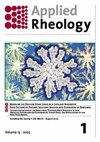Cubic autocatalysis implementation in blood for non-Newtonian tetra hybrid nanofluid model through bounded artery
IF 1.8
4区 工程技术
Q1 MECHANICS
引用次数: 0
Abstract
Tetra hybrid nanofluids are significant due to their unique properties like thermal and electrical conductivity enhancement, increased heat transfer, and improved fluid flow characteristics. This attempt proposes a tetra hybrid cross nanofluid model with the implementation of cubic autocatalysis in the context of blood flow passing through a stenosis artery. The model includes the effects of nanofluid, magnetic field, thermal radiation, and the cubic autocatalysis mechanism. This research investigates the innovative application of cubic autocatalysis within the context of blood flow through a tetra hybrid cross nanofluid model, specifically designed to simulate conditions within a stenosis horizontal artery. The equations governing the fluid flow are solved using the bvp5c method, and the numerical solutions are obtained for various parameter values. Specifically, the cubic autocatalysis mechanism profoundly impacts the velocity and concentration profiles of the blood flow. The proposed model and the obtained results provide new insights into the physics of blood flow passing through stenosis arteries. They may have important implications for the diagnosis and treatment of cardiovascular diseases. This article has a unique combination of tetra hybrid cross nanofluid model, cubic autocatalysis, and blood flow passing through the stenosis artery. These facts are not typically studied together in the context of blood flow.非牛顿四元混合纳米流体模型通过有界动脉在血液中实现立方自催化作用
四元杂交纳米流体具有独特的性能,如导热性和导电性增强、传热性提高和流体流动特性改善等,因此意义重大。本论文以血流通过狭窄动脉为背景,提出了一种四元混合交叉纳米流体模型,并实施了立方自催化。该模型包括纳米流体、磁场、热辐射和立方自催化机制的影响。这项研究通过四元混合交叉纳米流体模型,研究了立方自催化在血流中的创新应用,该模型专门用于模拟狭窄水平动脉内的情况。使用 bvp5c 方法求解了流体流动方程,并获得了各种参数值的数值解。具体而言,立方体自催化机制对血流的速度和浓度剖面产生了深远影响。所提出的模型和得到的结果为研究血流通过狭窄动脉的物理现象提供了新的视角。它们可能对心血管疾病的诊断和治疗具有重要意义。本文将四元杂交纳米流体模型、立方自催化和通过狭窄动脉的血流独特地结合在一起。在血流方面,这些事实通常不会一起研究。
本文章由计算机程序翻译,如有差异,请以英文原文为准。
求助全文
约1分钟内获得全文
求助全文
来源期刊

Applied Rheology
物理-力学
CiteScore
3.00
自引率
5.60%
发文量
7
审稿时长
>12 weeks
期刊介绍:
Applied Rheology is a peer-reviewed, open access, electronic journal devoted to the publication in the field of applied rheology. The journal provides the readers with free, instant, and permanent access to all content worldwide; and the authors with extensive promotion of published articles, long-time preservation, language-correction services, no space constraints and immediate publication.
 求助内容:
求助内容: 应助结果提醒方式:
应助结果提醒方式:


